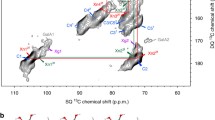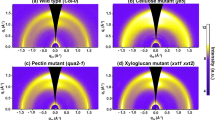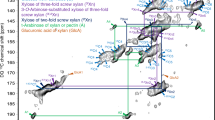Abstract
The interaction mechanism of two plant cell wall polysaccharides, arabinoxylan and xyloglucan, with cellulose has been investigated by means of bacterial cellulose fermentation to mimic the cell wall biosynthesis process. The combination of small angle scattering techniques with XRD and SEM has enabled the identification of different structural features comprising hierarchically-assembled bacterial cellulose, i.e. cellulose microfibrils and ribbons. The SANS results have been described by a core–shell formalism, which accounts for the presence of regions with different solvent accessibility and supports the existence of microfibril sub-structure within the ribbons. Additionally, SAXS and XRD results suggest that the microfibril packing and crystalline structure are not affected by arabinoxylan, while xyloglucan interferes with the crystallization and assembly processes, resulting in less crystalline Iβ-rich microfibrils. This specific interaction mechanism is therefore crucial for the cellulose microfibril cross-linking effect of xyloglucan in plant cell walls. It is proposed that the distinct interaction mechanisms identified have their origin in the differential structural role of arabinoxylan and xyloglucan in plant cell walls.








Similar content being viewed by others
References
Abràmoff MD, Magalhães PJ, Ram SJ (2004) Image processing with imageJ. Biophotonics Int 11:36–41
Astley OM, Chanliaud E, Donald AM, Gidley MJ (2001) Structure of acetobacter cellulose composites in the hydrated state. Int J Biol Macromol 29:193–202
Astley OM, Chanliaud E, Donald AM, Gidley MJ (2003) Tensile deformation of bacterial cellulose composites. Int J Biol Macromol 32:28–35
Baskin TI (2005) Anisotropic expansion of the plant cell wall. Annu Rev Cell Dev Biol 21:203–222
Blazek J, Gilbert EP (2011) Application of small-angle X-ray and neutron scattering techniques to the characterisation of starch structure: a review. Carbohydr Polym 85:281–293
Bootten TJ, Harris PJ, Melton LD, Newman RH (2008) WAXS and C-13 NMR study of Gluconoacetobacter xylinus cellulose in composites with tamarind xyloglucan. Carbohydr Res 343:221–229
Brown RM Jr (1996) The biosynthesis of cellulose. J Macromol Sci Pure Appl Chem 33:1345–1373
Burton RA, Gidley MJ, Fincher GB (2010) Heterogeneity in the chemistry, structure and function of plant cell walls. Nat Chem Biol 6:724–732
Castro C, Zuluaga R, Putaux JL, Caro G, Mondragon I, Gañán P (2011) Structural characterization of bacterial cellulose produced by Gluconacetobacter swingsii sp. from Colombian agroindustrial wastes. Carbohydr Polym 84:96–102
Cerclier CV, Guyomard-Lack A, Cousin F, Jean B, Bonnin E, Cathala B, Moreau C (2013) Xyloglucan–cellulose nanocrystal multilayered films: effect of film architecture on enzymatic hydrolysis. Biomacromolecules 14:3599–3609
Chanliaud E, Gidley MJ (1999) In vitro synthesis and properties of pectin/Acetobacter xylinus cellulose composites. Plant J 20:25–35
Chen W, Lickfield GC, Yang CQ (2004) Molecular modeling of cellulose in amorphous state. Part I: model building and plastic deformation study. Polymer 45:1063–1071
Cosgrove DJ (2005) Growth of the plant cell wall. Nat Rev Mol Cell Biol 6:850–861
Fan L, Degen M, Bendle S, Grupido N, Ilavsky J (2010) The absolute calibration of a small-angle scattering instrument with a laboratory X-ray source. J Phys Conf Ser. doi:10.1088/1742-6596/247/1/012005
Fernandes AN et al (2011) Nanostructure of cellulose microfibrils in spruce wood. Proc Natl Acad Sci USA 108:E1195–E1203
Fink HP, Hofmann D, Philipp B (1995) Some aspects of lateral chain order in cellulosics from X-ray scattering. Cellulose 2:51–70
Fink HP, Purz HJ, Bohn A, Kunze J (1997) Investigation of the supramolecular structure of never dried bacterial cellulose. Macromol Symp 120:207–217
Geitmann A (2010) Mechanical modeling and structural analysis of the primary plant cell wall. Curr Opin Plant Biol 13:693–699
Gilbert EP, Schulz JC, Noakes TJ (2006) ‘Quokka’-the small-angle neutron scattering instrument at OPAL. Phys B 385–386:1180–1182
Gilbert EP, Lopez-Rubio A, Gidley MJ (2012) Characterisation techniques in food materials science. In: Bhesh B, Yrjo R (eds) Food materials science and engineering. Wiley-Blackwell, p 52–93
Gu J, Catchmark JM (2012) Impact of hemicelluloses and pectin on sphere-like bacterial cellulose assembly. Carbohydr Polym 88:547–557
Gu J, Catchmark JM (2013) The impact of cellulose structure on binding interactions with hemicellulose and pectin. Cellulose 20:1613–1627
Gu J, Catchmark JM (2014) Roles of xyloglucan and pectin on the mechanical properties of bacterial cellulose composite films. Cellulose 21:275–289
Haigler CH, Brown RM Jr, Benziman M (1980) Calcofluor white ST alters the in vivo assembly of cellulose microfibrils. Science 210:903–906
Haigler CH, White AR, Brown RM Jr, Cooper KM (1982) Alteration of in vivo cellulose ribbon assembly by carboxymethylcellulose and other cellulose derivatives. J Cell Biol 94:64–69
He J et al (2014) Controlled incorporation of deuterium into bacterial cellulose. Cellulose 21:927–936
Heiner AP, Teleman O (1997) Interface between monoclinic crystalline cellulose and water: breakdown of the odd/even duplicity. Langmuir 13:511–518
Hirai A, Tsuji M, Yamamoto H, Horii F (1998) In situ crystallization of bacterial cellulose—III. Influences of different polymeric additives on the formation of microfibrils as revealed by transmission electron microscopy. Cellulose 5:201–213
Iguchi M, Yamanaka S, Budhiono A (2000) Bacterial cellulose—a masterpiece of nature’s arts. J Mater Sci 35:261–270
Ilavsky J, Jemian PR (2009) Irena: tool suite for modeling and analysis of small-angle scattering. J Appl Crystallogr 42:347–353
Jungnikl K, Paris O, Fratzl P, Burgert I (2008) The implication of chemical extraction treatments on the cell wall nanostructure of softwood. Cellulose 15:407–418
Kennedy CJ, Cameron GJ, Sturcova A, Apperley DC, Altaner C, Wess TJ, Jarvis MC (2007) Microfibril diameter in celery collenchyma cellulose: X-ray scattering and NMR evidence. Cellulose 14:235–246
Kent MS et al (2010) Study of enzymatic digestion of cellulose by small angle neutron scattering. Biomacromolecules 11:357–368
Khandelwal M, Windle AH (2014) Small angle X-ray study of cellulose macromolecules produced by tunicates and bacteria. Int J Biol Macromol 68:215–217
Kline SR (2006) Reduction and analysis of SANS and USANS data using IGOR Pro. J Appl Crystallogr 39:895–900
Koizumi S, Yue Z, Tomita Y, Kondo T, Iwase H, Yamaguchi D, Hashimoto T (2008) Bacterium organizes hierarchical amorphous structure in microbial cellulose. Eur Phys J E 26:137–142
Koizumi S, Tomita Y, Kondo T, Hashimoto T (2009) What factors determine hierarchical structure of microbial cellulose—interplay among physics, chemistry and biology. Macromol Symp 279:110–118
Langan P et al (2014) Common processes drive the thermochemical pretreatment of lignocellulosic biomass. Green Chem 16:63–68
Lopez-Rubio A, Gilbert EP (2009) Neutron scattering: a natural tool for food science and technology research. Trends Food Sci Technol 20:576–586
Martínez-Sanz M, Lopez-Rubio A, Lagaron J (2011) Optimization of the nanofabrication by acid hydrolysis of bacterial cellulose nanowhiskers. Carbohydr Polym 85:228–236
Matthews JF et al (2006) Computer simulation studies of microcrystalline cellulose Iβ. Carbohydr Res 341:138–152
McKenna BA, Mikkelsen D, Wehr JB, Gidley MJ, Menzies NW (2009) Mechanical and structural properties of native and alkali-treated bacterial cellulose produced by Gluconacetobacter xylinus strain ATCC 53524. Cellulose 16:1047–1055
Mikkelsen D, Gidley MJ (2011) Formation of cellulose-based composites with hemicelluloses and pectins using Gluconacetobacter fermentation (Clifton, NJ). Methods Mol Biol 715:197–208
Mikkelsen D, Gidley MJ, Williams BA (2011) In vitro fermentation of bacterial cellulose composites as model dietary fibers. J Agric Food Chem 59:4025–4032
Mikkelsen D, Flanagan BM, Wilson SM, Bacic A, Gidley MJ (2015) Bacterial cellulose composites suggest arabinoxylans and (1 → 3)(1 → 4)-β-d-glucans are not functional equivalents of either xyloglucans or pectins in plant cell walls. Biomacromolecules (in press)
Olsson RT, Kraemer R, Lopez-Rubio A, Torres-Giner S, Ocio MJ, Lagaron JM (2010) Extraction of microfibrils from bacterial cellulose networks for electrospinning of anisotropic biohybrid fiber yarns. Macromolecules 43:4201–4209
Park YB, Cosgrove DJ (2012) A revised architecture of primary cell walls based on biomechanical changes induced by substrate-specific endoglucanases. Plant Physiol 158:1933–1943
Park YB, Lee CM, Kafle K, Park S, Cosgrove DJ, Kim SH (2014) Effects of plant cell wall matrix polysaccharides on bacterial cellulose structure studied with vibrational sum frequency generation spectroscopy and X-ray diffraction. Biomacromolecules 15:2718–2724
Pauly M, Albersheim P, Darvill A, York WS (1999) Molecular domains of the cellulose/xyloglucan network in the cell walls of higher plants. Plant J 20:629–639
Penttilä PA et al (2010) Changes in submicrometer structure of enzymatically hydrolyzed microcrystalline cellulose. Biomacromolecules 11:1111–1117
Penttilä PA et al (2013) Small-angle scattering study of structural changes in the microfibril network of nanocellulose during enzymatic hydrolysis. Cellulose 20:1031–1040
Pingali SV et al (2010) Breakdown of cell wall nanostructure in dilute acid pretreated biomass. Biomacromolecules 11:2329–2335
Reiterer A, Lichtenegger H, Tschegg S, Fratzl P (1999) Experimental evidence for a mechanical function of the cellulose microfibril angle in wood cell walls. Philos Mag A 79:2173–2184
Scheller HV, Ulvskov P (2010) Hemicelluloses. Annu Rev Plant Biol 61:263–289
Svergun DI, Richard S, Koch MHJ, Sayers Z, Kuprin S, Zaccai G (1998) Protein hydration in solution: experimental observation by X-ray and neutron scattering. Proc Natl Acad Sci 95:2267–2272
Thomas LH et al (2013) Structure of cellulose microfibrils in primary cell walls from collenchyma. Plant Physiol 161:465–476
Tischer PCSF, Sierakowski MR, Westfahl H, Tischer CA (2010) Nanostructural reorganization of bacterial cellulose by ultrasonic treatment. Biomacromolecules 11:1217–1224
Tokoh C, Takabe K, Fujita M, Saiki H (1998) Cellulose synthesized by Acetobacter xylinum in the presence of acetyl glucomannan. Cellulose 5:249–261
Tokoh C, Takabe K, Sugiyama J, Fujita M (2002a) CP/MAS 13C NMR and electron diffraction study of bacterial cellulose structure affected by cell wall polysaccharides. Cellulose 9:351–360
Tokoh C, Takabe KJ, Fujita M (2002b) Cellulose synthesized by Acetobacter xylinum in the presence of plant cell wall polysaccharides. Cellulose 9:65–74
Uhlin KI, Atalla RH, Thompson NS (1995) Influence of hemicelluloses on the aggregation patterns of bacterial cellulose. Cellulose 2:129–144
Wada M, Sugiyama J, Okano T (1993) Native celluloses on the basis of two crystalline phase (I-alpha/I-beta) system. J Appl Polym Sci 49:1491–1496
Wang N, Ding E, Cheng R (2007) Thermal degradation behaviors of spherical cellulose nanocrystals with sulfate groups. Polymer 48:3486–3493
Weimer PJ, Hackney JM, Jung H-JG, Hatfield RD (2000) Fermentation of a bacterial cellulose/xylan composite by mixed ruminal microflora: implications for the role of polysaccharide matrix interactions in plant cell wall biodegradability. J Agric Food Chem 48:1727–1733
White AR, Brown RM Jr (1981) Enzymatic hydrolysis of cellulose: visual characterization of the process. Proc Natl Acad Sci USA 78:1047–1051
Whitney SE, Brigham JE, Darke AH, Reid JS, Gidley MJ (1995) In vitro assembly of cellulose/xyloglucan networks: ultrastructural and molecular aspects. Plant J 8:491–504
Whitney SEC, Brigham JE, Darke AH, Reid JSG, Gidley MJ (1998) Structural aspects of the interaction of mannan-based polysaccharides with bacterial cellulose. Carbohydr Res 307:299–309
Whitney SEC, Wilson E, Webster J, Bacic A, Reid JSG, Gidley MJ (2006) Effects of structural variation in xyloglucan polymers on interactions with bacterial cellulose. Am J Bot 93:1402–1414
Yamamoto H, Horii F, Hirai A (1996) In situ crystallization of bacterial cellulose. 2. Influences of different polymeric additives on the formation of celluloses I-alpha and I-beta at the early stage of incubation. Cellulose 3:229–242
Zhang K (2013) Illustration of the development of bacterial cellulose bundles/ribbons by Gluconacetobacter xylinus via atomic force microscopy. Appl Microbiol Biotechnol 97:4353–4359
Acknowledgments
The authors thank Dr. Joel Davis (ANSTO, Institute of Materials Engineering) for performing the SEM imaging and Dr. Tracey Hanley (ANSTO, Institute of Materials Engineering) for her valuable assistance with the XRD experiments. Dongjie Wang is acknowledged for composites production and SEM of fresh samples. M.M.S. would like to acknowledge a postdoctoral fellowship jointly funded by ANSTO and the ARC Centre of Excellence in Plant Cell Walls.
Author information
Authors and Affiliations
Corresponding author
Electronic supplementary material
Below is the link to the electronic supplementary material.
Rights and permissions
About this article
Cite this article
Martínez-Sanz, M., Lopez-Sanchez, P., Gidley, M.J. et al. Evidence for differential interaction mechanism of plant cell wall matrix polysaccharides in hierarchically-structured bacterial cellulose. Cellulose 22, 1541–1563 (2015). https://doi.org/10.1007/s10570-015-0614-2
Received:
Accepted:
Published:
Issue Date:
DOI: https://doi.org/10.1007/s10570-015-0614-2




